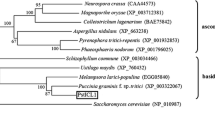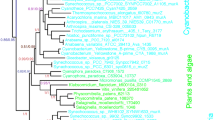Abstract
Key message
Homologous genes for the peptidoglycan precursor flippase MurJ, and peptidoglycan hydrolases: lytic transglycosylase MltB, and dd-carboxypeptidase VanY are required for chloroplast division in the moss Physcomitrella patens.
Abstract
The moss Physcomitrella patens is used as a model plant to study plastid peptidoglycan biosynthesis. In bacteria, MurJ flippase transports peptidoglycan precursors from the cytoplasm to the periplasm. In this study, we identified a MurJ homolog (PpMurJ) in the P. patens genome. Bacteria employ peptidoglycan degradation and recycling pathways for cell division. We also searched the P. patens genome for genes homologous to bacterial peptidoglycan hydrolases and identified genes homologous for the lytic transglycosylase mltB, N-acetylglucosaminidase nagZ, and ld-carboxypeptidase ldcA in addition to a putative dd-carboxypeptidase vanY reported previously. Moreover, we found a ß-lactamase-like gene (Pplactamase). GFP fusion proteins with either PpMltB or PpVanY were detected in the chloroplasts, whereas fusion proteins with PpNagZ, PpLdcA, or Pplactamase localized in the cytoplasm. Experiments seeking PpMurJ-GFP fusion proteins failed. PpMurJ gene disruption in P. patens resulted in the appearance of macrochloroplasts in protonemal cells. Compared with the numbers of chloroplasts in wild-type plants (38.9 ± 4.9), PpMltB knockout and PpVanY knockout had lower numbers of chloroplasts (14.3 ± 6.7 and 28.1 ± 5.9, respectively). No differences in chloroplast numbers were observed after PpNagZ, PpLdcA, or Pplactamase single-knockout. Chloroplast numbers in PpMltB/PpVanY double-knockout cells were similar to those in PpMltB single-knockout cells. Zymogram analysis of the recombinant PpMltB protein revealed its peptidoglycan hydrolase activity. Our results imply that PpMurJ, PpMltB and PpVanY play a critical role in chloroplast division in the moss P. patens.





Similar content being viewed by others
References
Alcorlo M, Martínez-Caballero S, Molina R, Hermoso JA (2017) Carbohydrate recognition and lysis by bacterial peptidoglycan hydrolases. Curr Opin Struct Biol 44:87–100. https://doi.org/10.1016/j.sbi.2017.01.001
Ashton NW, Cove DJ (1977) The isolation and preliminary characterisation of auxotrophic and analogue resistant mutants of the moss, Physcomitrella patens. Mol Gen Genet 154:87–95
Cheng Q, Li H, Merdek K, Park JT (2000) Molecular characterization of the ß -N-acetylglucosaminidase of Escherichia coli and its role in cell wall recycling. J Bacteriol 182:4836–4840
Chiu W-L, Niwa Y, Zeng W, Hirano T, Kobayashi H, Sheen J (1996) Engineered GFP as a vital reporter in plants. Curr Biol 6:325–330
Ehlert K, Höltje JV, Templin MF (1995) Cloning and expression of a murein hydrolase lipoprotein from Escherichia coli. Mol Microbiol 16:761–768. https://doi.org/10.1111/j.1365-2958.1995.tb02437.x
Emanuelsson O, Nielsen H, Brunak S, von Heijne G (2000) Predicting subcellular localization of proteins based on their N-terminal amino acid sequence. J Mol Biol 300:1005–1016. https://doi.org/10.1006/jmbi.2000.3903
Fuss J, Liegmann O, Krause K, Rensing SA (2013) Green targeting predictor and ambiguous targeting predictor 2: the pitfalls of plant protein targeting prediction and of transient protein expression in heterologous systems. New Phytol 200:1022. https://doi.org/10.1111/nph.12433
Heidrich C, Ursinus A, Berger J, Schwarz H, Höltje J-V (2002) Effects of multiple deletions of murein hydrolases on viability, septum cleavage, and sensitivity to large toxic molecules in Escherichia coli. J Bacteriol 184:6093–6099. https://doi.org/10.1128/JB.184.22.6093-6099.2002
Higuchi H, Takechi K, Takano H (2016) Visualization of cyanelle peptidoglycan in Cyanophora paradoxa using a metabolic labeling method with click chemistry. Cytologia 81:357–358
Hirano T, Tanidokoro K, Shimizu Y, Kawarabayasi Y, Ohshima T, Sato M, Tadano S, Ishikawa H, Takio S, Takechi K, Takano H (2016) Moss chloroplasts are surrounded by a peptidoglycan wall containing d-amino acids. Plant Cell 28:1521–1532. https://doi.org/10.1105/tpc.16.00104
Homi S, Takechi K, Tanidokoro K, Sato H, Takio S, Takano H (2009) The peptidoglycan biosynthesis genes MurA and MraY are related to chloroplast division in the moss Physcomitrella patens. Plant Cell Physiol 50:2047–2056. https://doi.org/10.1093/pcp/pcp158
Kasten B, Reski R (1997) ß-lactam antibiotics inhibit chloroplast division in a moss (Physcomitrella patens) but not in tomato (Lycopersicon esculentum). J Plant Physiol 150:137–140
Katayama N, Takano H, Sugiyama M, Takio S, Sakai A, Tanaka K, Kuroiwa H, Ono K (2003) Effects of antibiotics that inhibit the bacterial peptidoglycan synthesis pathway on moss chloroplast division. Plant Cell Physiol 44:776–781
Kraft AR, Prabhu J, Ursinus A, Höltje JV (1999) Interference with murein turnover has no effect on growth but reduces ß -lactamase induction in Escherichia coli. J Bacteriol 181:7192–7198
Krogh A, Larsson B, von Heijne G, Sonnhammer EL (2001) Predicting transmembrane protein topology with a hidden Markov model: application to complete genomes. J Mol Biol 305:567–580. https://doi.org/10.1006/jmbi.2000.4315
Machida M, Takechi K, Sato H, Chung SJ, Kuroiwa H, Takio S, Seki M, Shinozaki K, Fujita T, Hasebe M, Takano H (2006) Genes for the peptidoglycan synthesis pathway are essential for chloroplast division in moss. Proc Natl Acad Sci USA 103:6753–6758. https://doi.org/10.1073/pnas.0510693103
Medina R, Johnson MG, Liu Y, Wickett NJ, Shaw AJ, Goffinet B (2019) Phylogenomic delineation of Physcomitrium (Bryophyta: Funariaceae) based on targeted sequencing of nuclear exons and their flanking regions rejects the retention of Physcomitrella, Physcomitridium and Aphanorrhegma. J Syst Evol 57:404–417. https://doi.org/10.1111/jse.12516
Miyagishima S-Y, Kabeya Y, Sugita C, Sugita M, Fujiwara T (2014) DipM is required for peptidoglycan hydrolysis during chloroplast division. BMC Plant Biol 14:57. https://doi.org/10.1186/1471-2229-14-57
Nishiyama T, Hiwatashi Y, Sakakibara I, Kato M, Hasebe M (2000) Tagged mutagenesis and gene-trap in the moss, Physcomitrella patens by shuttle mutagenesis. DNA Res 7:9–17
Park JT, Uehara T (2008) How bacteria consume their own exoskeletons (turnover and recycling of cell wall peptidoglycan). Microbiol Mol Biol Rev 72:211–227. https://doi.org/10.1128/MMBR.00027-07
Pratt RF (2016) β-Lactamases: why and how. J Med Chem 59:8207–8220. https://doi.org/10.1021/acs.jmedchem.6b00448
Rensing SA, Lang D, Zimmer AD et al (2008) The Physcomitrella genome reveals evolutionary insights into the conquest of land by plants. Science 319:64–69. https://doi.org/10.1126/science.1150646
Ruiz N (2008) Bioinformatics identification of MurJ (MviN) as the peptidoglycan lipid II flippase in Escherichia coli. Proc Natl Acad Sci USA 105:15553–15557. https://doi.org/10.1073/pnas.0808352105
Sakakibara K, Nishiyama T, Deguchi H, Hasebe M (2008) Class 1 KNOX genes are not involved in shoot development in the moss Physcomitrella patens but do function in sporophyte development. Evol Dev 10:555–566. https://doi.org/10.1111/j.1525-142X.2008.00271.x
Sakakibara K, Reisewitz P, Aoyama T, Friedrich T, Ando S, Sato Y, Tamada Y, Nishiyama T, Hiwatashi Y, Kurata T, Ishikawa M, Deguchi H, Rensing SA, Werr W, Murata T, Hasebe M, Laux T (2014) WOX13-like genes are required for reprogramming of leaf and protoplast cells into stem cells in the moss Physcomitrella patens. Development 141:1660–1670. https://doi.org/10.1242/dev.097444
Sato N, Takano H (2017) Diverse origins of enzymes involved in the biosynthesis of chloroplast peptidoglycan. J Plant Res 130:635–645. https://doi.org/10.1007/s10265-017-0935-3
Sato N, Toyoshima M, Tajima N, Takechi K, Takano H (2017) Single-pixel densitometry revealed the presence of peptidoglycan in the intermembrane space of the moss chloroplast envelope in conventional electron micrographs. Plant Cell Physiol 58:1743–1751. https://doi.org/10.1093/pcp/pcx113
Scheurwater E, Reid CW, Clarke AJ (2008) Lytic transglycosylases: bacterial space-making autolysins. Int J Biochem Cell Biol 40:586–591. https://doi.org/10.1016/j.biocel.2007.03.018
Sham L-T, Butler EK, Lebar MD, Kahne D, Bernhardt TG, Ruiz N (2014) Bacterial cell wall. MurJ is the flippase of lipid-linked precursors for peptidoglycan biogenesis. Science 345:220–222. https://doi.org/10.1126/science.1254522
Suvorov M, Lee M, Hesek D, Boggess B, Mobashery S (2008) Lytic transglycosylase MltB of Escherichia coli and its role in recycling of peptidoglycan strands of bacterial cell wall. J Am Chem Soc 130:11878–11879. https://doi.org/10.1021/ja805482b
Takahashi Y, Takechi K, Takio S, Takano H (2016) Both the transglycosylase and transpeptidase functions in plastid penicillin-binding protein are essential for plastid division in Physcomitrella patens. Proc Jpn Acad Ser B 92:499–508
Takano H, Takechi K (2010) Plastid peptidoglycan. Biochim Biophys Acta 1800:144–151. https://doi.org/10.1016/j.bbagen.2009.07.020
Takano H, Tsunefuka T, Takio S, Ishikawa H, Takechi K (2018) Visualization of plastid peptidoglycan in the charophyte alga Klebsormidium nitens using a metabolic labeling method. Cytologia 83:375–380. https://doi.org/10.1508/cytologia.83.375
Templin MF, Ursinus A, Höltje JV (1999) A defect in cell wall recycling triggers autolysis during the stationary growth phase of Escherichia coli. EMBO J 18:4108–4117. https://doi.org/10.1093/emboj/18.15.4108
Typas A, Banzhaf M, Gross CA, Vollmer W (2012) From the regulation of peptidoglycan synthesis to bacterial growth and morphology. Nat Rev Microbiol 10:123–136. https://doi.org/10.1038/nrmicro2677
van Heijenoort J (2011) Peptidoglycan hydrolases of Escherichia coli. Microbiol Mol Biol Rev 75:636–663. https://doi.org/10.1128/MMBR.00022-11
Vermassen A, Leroy S, Talon R, Provot C, Popowska M, Desvaux M (2019) Cell wall hydrolases in bacteria: Insight on the diversity of cell wall amidases, glycosidases and peptidases toward peptidoglycan. Front Microbiol 10:331. https://doi.org/10.3389/fmicb.2019.00331
Vollmer W (2008) Structural variation in the glycan strands of bacterial peptidoglycan. FEMS Microbiol Rev 32:287–306. https://doi.org/10.1111/j.1574-6976.2007.00088.x
Wu X, Huang R, Liu Z, Zhang G (2013) Functional characterization of cis-elements conferring vascular vein expression of At4g34880 amidase family protein gene in Arabidopsis. PLoS ONE 8:e67562. https://doi.org/10.1371/journal.pone.0067562
Acknowledgements
This work was supported by the Japan Society for the Promotion of Science KAKENHI (Grant Number 17H03701). We are grateful to Sayaka Koshigae, and Ayane Tanaka (Kumamoto University) for their assistance.
Funding
The Japan Society for the Promotion of Science KAKENHI (Grant Number 17H03701).
Author information
Authors and Affiliations
Contributions
HT and KT designed the study, analyzed the data, and wrote the manuscript. HU, NS, HK, MF, SH, MU and KT performed the experiments. All authors read and approved the final manuscript.
Corresponding authors
Ethics declarations
Conflict of interest
The authors declare that they have no competing interest.
Additional information
Publisher's Note
Springer Nature remains neutral with regard to jurisdictional claims in published maps and institutional affiliations.
Electronic supplementary material
Below is the link to the electronic supplementary material.
Rights and permissions
About this article
Cite this article
Utsunomiya, H., Saiki, N., Kadoguchi, H. et al. Genes encoding lipid II flippase MurJ and peptidoglycan hydrolases are required for chloroplast division in the moss Physcomitrella patens. Plant Mol Biol 107, 405–415 (2021). https://doi.org/10.1007/s11103-020-01081-0
Received:
Accepted:
Published:
Issue Date:
DOI: https://doi.org/10.1007/s11103-020-01081-0




